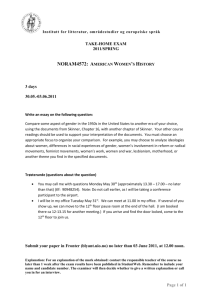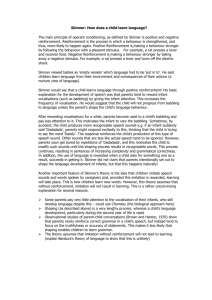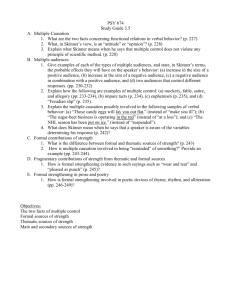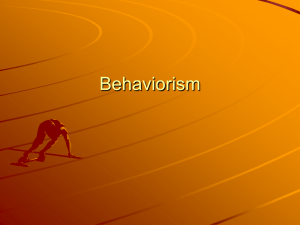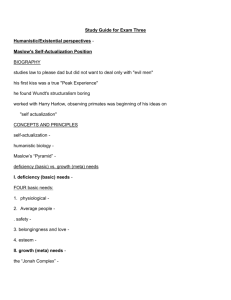Skinner and Staats
advertisement
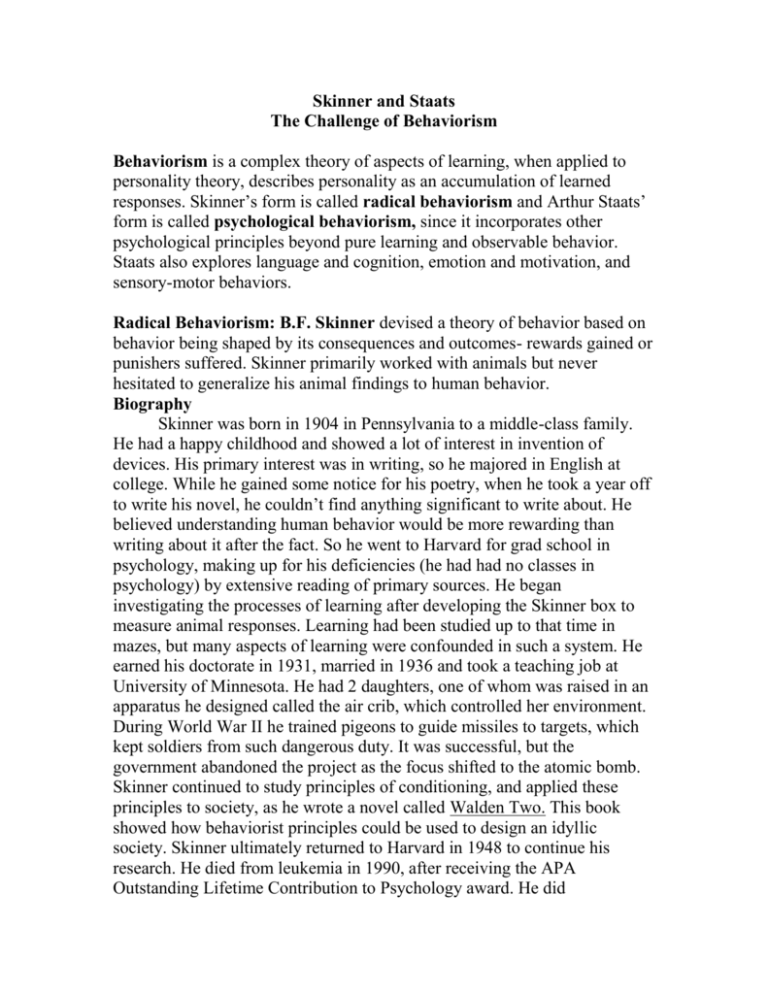
Skinner and Staats The Challenge of Behaviorism Behaviorism is a complex theory of aspects of learning, when applied to personality theory, describes personality as an accumulation of learned responses. Skinner’s form is called radical behaviorism and Arthur Staats’ form is called psychological behaviorism, since it incorporates other psychological principles beyond pure learning and observable behavior. Staats also explores language and cognition, emotion and motivation, and sensory-motor behaviors. Radical Behaviorism: B.F. Skinner devised a theory of behavior based on behavior being shaped by its consequences and outcomes- rewards gained or punishers suffered. Skinner primarily worked with animals but never hesitated to generalize his animal findings to human behavior. Biography Skinner was born in 1904 in Pennsylvania to a middle-class family. He had a happy childhood and showed a lot of interest in invention of devices. His primary interest was in writing, so he majored in English at college. While he gained some notice for his poetry, when he took a year off to write his novel, he couldn’t find anything significant to write about. He believed understanding human behavior would be more rewarding than writing about it after the fact. So he went to Harvard for grad school in psychology, making up for his deficiencies (he had had no classes in psychology) by extensive reading of primary sources. He began investigating the processes of learning after developing the Skinner box to measure animal responses. Learning had been studied up to that time in mazes, but many aspects of learning were confounded in such a system. He earned his doctorate in 1931, married in 1936 and took a teaching job at University of Minnesota. He had 2 daughters, one of whom was raised in an apparatus he designed called the air crib, which controlled her environment. During World War II he trained pigeons to guide missiles to targets, which kept soldiers from such dangerous duty. It was successful, but the government abandoned the project as the focus shifted to the atomic bomb. Skinner continued to study principles of conditioning, and applied these principles to society, as he wrote a novel called Walden Two. This book showed how behaviorist principles could be used to design an idyllic society. Skinner ultimately returned to Harvard in 1948 to continue his research. He died from leukemia in 1990, after receiving the APA Outstanding Lifetime Contribution to Psychology award. He did significantly impact the direction of psychology, with his movement being called the second wave of psychology, following psychoanalytic theory. It did push psychology into the mainstream of hard science, as he only studied observable phenomena, and found infinite numbers of ways to control and predict these behaviors. Later behaviorists added the cognitive aspects to human behavior to understanding, as Skinner’s version of understanding the human being left out the very humanity for which humans are noted. Behavior as the Data for Scientific Study- Skinner didn’t suggest causes of behavior as coming from within the person, as a result of personality differences. He thought personality theories up to then had been contaminated by circular reasoning; that personality was not scientifically measurable, so was of no interest to science. (Traits are inferred from behavior, so they are simply summary descriptions of behavior.) Skinner only wanted to know what controlled behavior, so he concentrated on changing things in the environment to see how they affected behavioral outputs. So he focused on the environmental explanations, rewards and punishments to explain behavior. They were easier for scientists to manipulate and observe. Since Skinner eschewed any internal explanations for behavior, his theory was called radical behaviorism. He believed one didn’t need to understand any internal variables (intervening cognitive variables) to manipulate behavior, so they were unnecessary to study. Yet we know that thoughts often cause behavior- we act on thoughts. Everything that was ever created by man was first a thought. Yet Skinner was not interested- it was enough to study the observable results- behavior. He believed thoughts were merely collateral products of environmental factors that also cause behavior. He also stressed means of control of behavior. The evolutionary context of operant behavior- Humans are so successful as a species because we have learned to adapt to changing environments. This skill came to us through evolution, as the most adaptive humans survived to reproduce most successfully. Operant conditioning is the selection of behavior due to its consequences. The rate of responding shows the effectiveness of learning. As animals learn a behavior, they display it more rapidly and effectively to gain their rewards. So Skinner used lower animals to control their environments more completely and ascertain what affects rates of response. He developed the Skinner box, an apparatus which can be adjusted to provide rewards at a pace desired by the researcher, and allow the animal to respond according to its learning speed. These responses are called operant responses, responses freely emitted by the animal, that were recorded on a print out. Rat responses were level presses, while pigeons’ responses were disk pecking. So Skinner built on the animal’s natural response repertoire. Learning Principles: rates of responding can be increased by reinforcement, and decreased by punishment/ extinction. Reinforcement: Increasing the Rate of Responding o Positive reinforcer is any stimulus that strengthens the behavior it follows. o Base rate of response is first ascertained in a study- what does the subject do without any particular response in the environment? This base rate must be known in order to measure any response increase or decrease after reinforcers are used. o Primary reinforcers are innate gratifying results- food when hungry, water when thirsty, sex when deprived. Nothing must be learned for these to be reinforcing. o Secondary reinforcers are things whose value has been learned- praise, money, attention. People have varying responses to these secondary reinforcers. The same thing which triggers one person to work into a frenzy doesn’t affect another person much at all. The effects must be noted to understand whether a consequence is reinforcing or not. So Skinner actually developed an idiographic approach to study of personality- one must understand the unique reinforcement history of the subject to understand his particular response pattern. o Negative reinforcer is any stimulus that increases a response by being withdrawn. So the behavior increases when the aversive stimulus ends or is escaped. This is not the same as punishment, which is designed to get the subject to stop responding. Punishment and Extinction: Decreasing the Rate of Responding Punishment reduces the rate of responding. It is an aversive that appears upon response. Unfortunately this is the most common parental discipline tool, yet it is not the most effective. Even religions use it to threaten the faithful into behaving themselves virtuously & controlling their lustful desires. There are unintended negative effects, though, such as developing fears/ anxieties in the children, resistance to the authority figure, & hidden rebellions in other places. It really only works if the authority figure is around to enforce the consequences, so the value is not internalized within the child. Skinner did not believe punishment was an effective means of behavior control. He believed positive reinforcement was much more effective, as it trained the child toward a positive goal instead of focused him/her on avoidance of a negative behavior. Extinction is a means of eliminating a behavior by simply no longer reinforcing it- by ignoring a distressing behavior, it will decline. Even after a behavior is eliminated, though, it may recur, as the child tests the environment to see if a reward might still be forthcoming. The problem with extinction in parenting is that children have more energy to continue a behavior than parents have in ignoring it! Also a distressing behavior often gets reinforcement from peers, siblings, not just parents. Additional behavioral techniques Shaping is a way of training in a new behavior that the animal or person has never done before. It relies on reinforcing successive approximations of the desired response. In the beginning of toilet training, the child is rewarded for simply sitting on the toilet. Gradually a response is emitted and rewarded and increases in frequency and accuracy. Then reinforcement is reduced until the behavior is learned and no longer needs reinforcement. Chaining is a means of training in complex sequences of behaviors. Generally it starts with the end behavior in mind and works backwards. Animal training may begin as simply as rewarding the killer whale for swimming over a stick lying in the bottom of the pool. The whale learns that the stick is significant and swims over it more determinately. Finally the stick is raised gradually until the whale begins leaping out of the water to get over the bar and receive a reward. Animals (and people) have been trained to do incredibly complex behaviors in such a painstaking manner of reward. The behaviors serve as triggers for the following behaviors, producing a chain of behaviors only rewarded at the final effort. Discrimination learning occurs when people/ animals learn a behavior in response to a stimulus in the environment. So when the pigeon saw a light go on, it knew to peck the key and it would be rewarded. If the light was off, there was no point in pecking the key. Discriminative stimuli are the environmental signals to respond. People respond to a variety of environmental signals with predictable behavior- stop on red, go on green. When they don’t, there is havoc. The problem may come if the discriminative stimulus is similar to other stimuli in the environment, producing confusion. Dogs were triggered to experience severe neurosis by training them to salivate in response to a circle, meaning they would get food, and not salivate to an oval, which offered no food (and in some experiments was associated with shock). As the oval and circle became more alike, the dogs were sent into whimpering, crying, and withdrawing to the corner of the cage when they couldn’t discriminate what might happen next. This can be used to understand hypervigilance in abuse children, anxiety and depression in victims of abuse, as they try to scan the environment for cues to what may happen to them. Generalization occurs when discriminative stimuli resemble other stimuli in the environment, and the animal responds to the other stimuli as if they were discriminative. This principle of generalized response allows us to learn behaviors and spread their usefulness into a variety of venues. So we don’t have to learn new behaviors every time we are faced with a new environment. This also explains much personality stability, as people act similarly across situations and differences in responses to other people and circumstances. Schedules of reinforcement are the contingencies that are set up between response and reinforcement. Even lower animals can discover the contingencies of reinforcement and behave accordingly. Penguins at the zoo come to the door for feeding on a regular time schedule, although the penguins aren’t reading clocks! Continuous reinforcement schedule is the best way to train in a new behavior- every response is reinforced quickly. They produce quick learning, but rapid extinction if the reward is discontinued. Partial reinforcement schedules are various ways of reinforcing responses in order to produce more long-term learning/ behaving. Usually these schedules are put in place after continuous reinforcement has established the behavior- it’s called leaning out the reinforcement schedule. o Fixed ratio reinforce after a fixed number of responses. The faster the responses are emitted, the more reinforcements given. This can work people to death if they are paid on a piecework basis. It’s also the source of workaholism in doctors, lawyers, and other people who get paid according to how many hours they bill. o Variable ratio is a reinforcement pattern that reinforces around an average of responses. It produces a high rate of response and is more resistant to extinction than FR. So the pigeon may have to peck 5 times, 15 times, 45 times, but the average is 25 times. o Fixed interval is reinforcement based on time- the pigeon will get a reward after 15 minutes, as soon as he pecks after that time. This produces a scalloped response pattern, with few responses after a reinforcement, but many as the time is up. This is what students do when they know there is an exam every Friday- they begin studying on Thursday night! o Variable interval reinforces around an average time, so the scalloped effect smoothes out a bit, producing more regular responses. (when the teacher uses regular, but unexpected pop quizzes.) Applications of Behavioral Techniques Therapy o Behavior modification applies learning principles to change an undesirable behavior. o Functional analysis is first made to identify the stimuli and reinforcers that keep this negative behavior in place. What are the environmental triggers for the behavior? It may be hard to find the specific triggers and rewards that have produced the behavior, but sometimes it is very clear- when a child cries in the store for candy and the mother gives him candy to get him to stop crying, he learns he can always get candy at the store if he will just cry repeatedly. Many parents don’t realize the power of intermittent reinforcement in producing undesirable behavior (even in their partners!) Then an intervention is planned- it may require changing the situation to eliminate the trigger, reinforcing more desirable behavior instead, or ignoring the behavior to begin extinction. o Token economies are using tokens for desired reinforcers. Tokens can stand for privileges, money, food, freedom, but they are manageable means of reward in a challenging environment, such as the classroom. They also allow for a menu of rewards to be used, which are variably appealing to numbers of children. The downside of using this controlling reward system is that children begin behaving only to gain reward, not because they want to learn a behavior or get good at a skill. It depletes the internal incentive to learn. These techniques are especially useful for people who don’t use language or respond to more social rewards- people with Alzheimer’s’, autism, language disability. It can produce rapid success in overcoming habits such as overeating, smoking, etc. Education- Skinner developed a teaching machine to present material in small increments, with rapid answers available to get feedback for one’s responses. He called it programmed instruction, which could allow a student to develop skills at her own pace. The problem is Skinner’s workbooks were incredibly boring and children hated them after awhile. The learning goals were so small in increments that the children quit before making a lot of progress. He never intended them to replace teachers or to deal with complex ideas of learning, just to learn specific skills. Today they have morphed into computer programs to aid students in learning skills in math or writing, reading. Radical Behaviorism and Personality Theory Skinner’s theory as applied to personality was criticized as insufficiently oriented toward human cognition, or inherited temperament. Social relationships are very complex and difficult to understand according to simple learning principles. The other criticism of Skinners’ theory has to do with the idea that people are truly not free to make their own life choices, as they are just a bundle of learned responses. Skinner said that a society could be developed according to learning principles which allowed maximum freedom of members, who had been trained to voluntarily behave as good citizens. This was the concept described in Walden Two. Some communities were actually developed on Skinner’s principles, but they rarely lasted long. Language was also an area of study for Skinner, but it caused great controversy with other researchers. Skinner called language “verbal behavior” and simply thought it was a component operant behavior. Language and thought were simply combinations of operants. Chomsky disagreed, saying there were cultural universals in the acquisition of language that showed it was an outcome of a specific part of the brain designed for language in humans. Children even produced unique words to express themselves, words which had not been used by anyone around them, but which were meaningful and understandable to others. These unique expressions could not have been learned through reinforcement. As a personality theory, Skinner’s theory is really only useful as an alternative to other internal personality theories. Psychological Behaviorism: Staats unlike Skinner, translated personality concepts into behavioral language. His psychological behaviorism incorporates biological influences, as well as social interaction, child development and measurement of traits. He did agree with Skinner that personality is built by learning, even more so than biology. Biography Arthur Staats was born in New York in 1924 of Jewish parents only recently in the US from Russia. He had a generally happy childhood, and he read a lot and was very athletic. His family was liberal and progressive, so he developed a world view that often separated him from others. This difference contributed to his original thought about the nature of human personality. He acquired a Ph.D. in Experimental Psychology at UCLA. He began teaching at Arizona State University, where he began his own human behavioral program. His discoveries applied to behavior modification, behavior therapy, and behavioral assessment. Much of his work has been incorporated in cognitive behavior therapy & personality assessment. He married his assistant, who collaborated on his research program, and they had a daughter in 1960. He raised his daughter and son according to training procedures developed in his lab. He was the developer of time-out procedures and token reinforcement. His theory is called unified positivism, which combines findings from biology and philosophy and social sciences. Reinforcement – since behavior is maintained by reinforcement, he developed 2 interventions to help produce more advantageous behaviors: Time-out procedure is the removal of a child from a reinforcing environment. This is commonly used today in parenting and school, since it is effective in reducing problematic behavior without using punitive measures. Token reinforcement program The other concept he developed had to do with the idea that rewards produce positive emotional responses and punishers produce negative emotional responses. So anything we feel emotional about can provide incentives to behave in a certain way, or avoid specific environments. So our own emotionality can be rewarding and determine behavior. This concept made it sensible to include classical conditioning in behaviorism. The theory became broader & more informative. Basic Behavioral Repertoires (BBRs) are behavioral chains that are built early in life, and continue for decades into adulthood. So behavioral repertoires lead to different behaviors. The most important repertoires are stepping stones for later, more complex learning. Staats did believe that personality (BBRs) is a cause of behavior. So, like the psychoanalytic theorists, Staats believed early human learning has special importance for personality. Learning is long-term, cumulative and complex, resulting from combinations of behaviors. If the basics aren’t learned early in life, later, more complex learning might not occur. Interventions can remediate early learning failures, & this can include social deficits. These BBRs come in 3 forms: The Emotional-Motivation Repertoire includes emotional responses to various stimuli. Some responses are built in by biology, such as positive emotional responses to food and negative responses to pain. Other emotional connections to other stimuli are made through classical conditioning. Fears & phobias are also developed in this way. Attachment to parents is formed through associations of parent with the comfort of food, holding, soft stroking. Then the parent may display displeasure, with frowning, yelling, and a child will associate negative feelings with whatever produced that reaction in the parent. So emotional learning all forms the emotional-motivational repertoire, which will partly determine behavior in a variety of life situations in the future. People approach pleasant stimuli and avoid negative, painful stimuli, based on past learning. The stronger the emotion, the stronger the tendency to approach or avoid. Once a parent’s frown is associated with negative feelings, the child will learn from the parent’s instruction. An abusive parent will teach maladaptive response patterns. So all the varieties of parenting styles will produce children with varied personalities, hobbies, interests and talents. The unique pattern of biological abilities and environmental triggers and reinforcers make for individual differences. Values developed early in life predispose people toward different careers, or even prejudices. So early basic emotional-motivational responses build the foundation for mature behavior. The Language-Cognitive Repertoire recognizes that language is primarily cognitive. One’s thoughts and self-directed speech can direct behavior, as does one’s expectations and biases. Children, who are encouraged to visualize words while they read, have an easier time understanding what they read. These children also develop stronger skills in reading and math. Once language for objects is in place, more abstract concepts can build on that basis. The Sensory-Motor Repertoire has to do with bodily-kinesthetic skill building. Body movements even reflect our beliefs about masculinity and femininity, and personal confidence. Practice can build competent behavior, not just in the athletic arena. Early motor development is clearly influenced by learning, as in some cultures, the parents engage in a complex physical routine in order to develop independent locomotion at an early age. This is thought to be a survival skill for people who live in threatening environments. Situations can affect behavior in 3 ways (three function learning theory, or A-R-D theory): Situations can arouse feelings and attitudes (A), having been associated with happiness or threat in the past. They can provide reinforcements (R) such as positive attention of peers, or an audience. They can direct behavior (D) by programming the next logical step at each point of learning. Psychological Adjustment requires much healthy learning. People who show maladjustment have failed to learn the basics of social functioning, personal responsibility, empathy toward others, etc. Deficits can lead toward pathologies: phobias, emotional illnesses such as anxiety or depression, autistic behaviors relating to affection and physical connections to others, language deficits for those with mental retardation or schizophrenia. One of the important aspects of developing ideally is learning to make positive, helpful self-statements. This relates to forming a positive self-concept, lightening one’s mood in the face of trials, balancing reasonable expectations while learning new things, and even self-reinforcement for difficult efforts toward improvement. Social learning can include understanding one’s effects on others, and learning to share and take cues from other people re: appropriate behavior. Other social behavior repertoires lead to healthy relationships with others, intimacy, successful work, and even leadership skills. Even the defense mechanisms that people use are learned. Defense mechanisms that don’t include learning from past failures can preclude any useful adaptation from failures or difficulties, and they won’t help the person improve in his weak areas. Perfectionism can be seen as an unhealthy form of learning unreasonable expectations, rigidity around rules, or even about cleanliness. So the positive aspect of this is if the pathological behaviors can be learned, they can be unlearned through appropriate behavioral internventions. The Nature-Nurture Question according to Staats is not a questionevolution gave us the ability to learn in new environments so we can survive. We adapt through learning and biology made this possible. Learning can influence biology, as it can restructure synaptic connections in the brain, develop our bodies, & give us skills to live longer lives. Learning is stored in biological representations, so biology impacts rate of learning and storage of new information and skill patterns. Some biologically based disorders (Down’s syndrome) can impact the ability to learn, but they can learn with the right environment. Staats described many specific ways of interacting with children to enhance their intellect, with counting games and language usage. He demonstrated how children from deprived backgrounds can develop improved reading, writing and math skills and show an average IQ gain of 12 points with the right interventions. He believed temperamental difficulties could be reduced with the right parenting skills. He even showed how cuter babies received more affection and positive interactions with parents than less attractive babies. This is certainly something that can be changed once noted. Personality Assessment The Act-Frequency Approach to Personality Measurement was developed out of the idea that behaviors could be used to measure personality. The approach uses systematic procedures for assessing the frequency of common, prototypical behaviors to infer certain personality traits. This approach is more accurate than using people’s own self-reports, as they are obviously more subjective. Contributions of Behaviorism to Personality Theory and Measurement – these theorists remind us that we cannot understand personality separate from the environment in which the person is behaving. People learn to behave in specific situations, and behavior differs in various environments. Staats’ theory is more comprehensive and unified than Skinner’s radical behaviorism.

